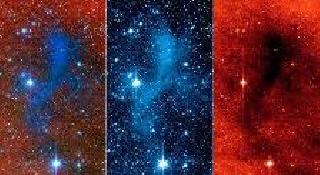
This series of images from NASA's Spitzer Space Telescope shows a dark mass of gas and dust, called a core, where new stars and planets will likely spring up. Photo by NASA/JPL-Caltech/Observatoire de Paris/CNRS
PASADENA, CALIFORNIA (BNS): A new cosmic phenomenon, termed 'coreshine' is revealing new information about stars and planets, astronomers said.
According to new study to be published in journal Science Friday, scientists used data from NASA's Spitzer Space Telescope to measure infrared light deflecting off cores -- cold, dark cocoons where young stars and planetary systems are blossoming.
They said this coreshine effect which occurs when starlight from nearby stars bounces off the cores is revealing information about their age and consistency.
Laurent Pagani of the Observatoire de Paris and the Centre National de la Recherche Scientifique and his team first observed one case of the coreshine phenomenon in 2009.
They found that the dust grains were bigger than previously thought -- about 1 micron instead of 0.1 micron (a typical human hair is about 100 microns).
The larger grain size means that planets -- which form as dust circling young stars sticks together -- might take shape more quickly. In other words, the tiny seeds for planet formation may be forming very early on, when a star is still in its pre-embryonic phase.
The researchers did not know if what they found was true of other dark clouds -- until now. In the new study they examine 110 dark cores, and find that about half of them exhibit coreshine.
The finding amounts to a new tool for not only studying the dust making up the dark cores, but also for assessing their age. The more developed star-forming cores will have larger dust grains, so, using this tool, astronomers can better map their ages across the Milky Way galaxy, NASA said.
 Previous Article
Previous Article Next Article
Next Article












The Indian Air Force, in its flight trials evaluation report submitted before the Defence Ministry l..
view articleAn insight into the Medium Multi-Role Combat Aircraft competition...
view articleSky enthusiasts can now spot the International Space Station (ISS) commanded by Indian-American astr..
view article